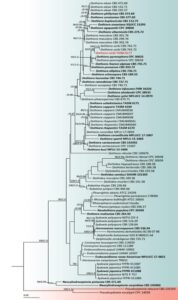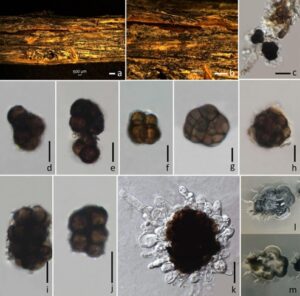Dothiora sorbi (Wahlenb.) Fuckel, Jb. nassau. Ver. Naturk. 23–24: 275 (1870)
Index Fungorum number: IF 233104; MycoBank number: MB 233104; Facesoffungi number: FoF17369
Saprobic on dead branches. Sexual morph: Undetermined. Asexual morph: hormonema-like. Conidiomata 50–200 × 75–150 μm (x̅ = 56 × 82 μm, n = 10), stromatic, solitary or aggregated in a stroma, numerous, dark brown to black, dry. Conidiophores 2.3–2.5 × 2.7–3.2 μm (x̅= 2.3 × 3.2 μm, n = 5), micronematous, reduced to conidiogenous cells. Conidia 13.2–24.5 × 14.1–30.3 μm (x̅ = 20.2 × 20.5 μm, n = 10), holoblastic, solitary, or formed in chains, chlamydospore-like, smooth- and thin to thick-walled, dark brown, globose, ellipsoid or irregularly-shaped, with longitudinal or oblique secondary septa over time, giving rise to a ‘muriform’ appearance, prominently constricted at septa when mature.
Culture characteristics – Colonies on MEA ranging from 20–35 mm diam., after three weeks at 25 °C, with margin submerged, irregular or undulating, rough at surface, mucoid, gummy with masses of moist conidia from mycelial conidiogenesis gathering in damp droplets, breaking down agar and forming cracks, pale olive-brown to dark olive, reverse dark olive-grey to whitish-grey.
Material examined – Uzbekistan, Tashkent Province, Bustonliq District, Chatkal State Biosphere Reserve, Western Tien Shan Mountains, on dead branches of Rosa webbiana (Rosaceae), 20 May 2016, Y. Gafforov and M. Yarasheva (TASM 6177), living culture MFLUCC 25–0169.
GenBank numbers – LSU = PV158287, SSU = PV158289, ITS = PV163078.
Notes – Phylogenetic analysis of combined LSU, SSU, and ITS sequence data placed our isolate (TASM 6177) within the genus Dothiora, forming a well-supported clade with Dothiora sorbi (CBS 742.71 and CBS 742.72) (82% ML bootstrap, 0.99 PP, Fig. 1). The ITS divergence from D. sorbi is relatively low (0.7%, 4/501 bp). However, TASM 6177 differs morphologically by producing a hormonema-like synasexual morph, which has not been described for D. sorbi. Our isolate develops stromatic, dark brown to black conidiomata directly on the host surface, along with large, muriform, thick-walled conidia that are globose to irregularly shaped–morphological features not previously documented in closely related species. Because the synasexual morph of D. sorbi remains unknown, direct morphological comparison was not possible. Therefore, we tentatively identified TASM 6177 as D. sorbi, denoting its close phylogenetic relationship while recognizing the need for additional data to confirm its identity. Although Dothiora species have previously been recorded in Uzbekistan, this is the first record of a Dothiora species on Rosa webbiana.

Figure 1 – Phylogram generated from maximum likelihood analysis based on combined LSU, SSU, and ITS sequence data from 82 taxa, comprising 2,270 characters (LSU = 898, SSU = 791, ITS = 581). The best-scoring RAxML tree with a final likelihood value of -8643.647 is presented. The matrix contained 505 distinct alignment patterns, with 38.88% of the characters being undetermined or gaps. Estimated base frequencies were as follows: A = 0.259, C = 0.220, G =
0.280, T = 0.241; substitution rates: AC = 1.553, AG = 2.735, AT = 1.613, CG = 0.917, CT = 7.508, GT = 1.0; gamma distribution shape parameter α = 0.553. Bootstrap support values for maximum likelihood (ML) equal to or greater than 70% and clade credibility values greater than 0.90 (rounded to two decimal places) from Bayesian inference analysis are labeled at each node. Ex-type strains are in bold, while the new isolate is indicated in red. The tree is rooted to Pseudosydowia eucalypti (CPC 14028) and Pseudoseptoria obscura (CBS 135103).

Figure 2 – Dothiora sorbi (TASM 6177, new host record). a, b Conidiomata on the host surface. c Conidiophores, conidiogenous cells, and conidia on the host. d–j Conidia. k Germinated conidium. l, m Culture characteristics on MEA (l: above view, m: reverse view). Scale bars: a, b = 1 mm, c, k = 20 μm, d–j = 10 μm.
